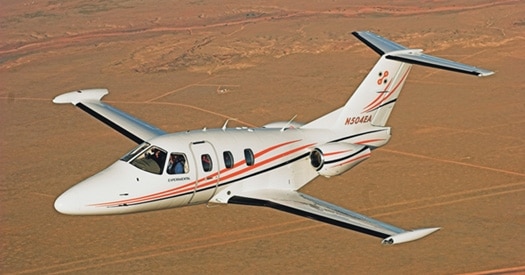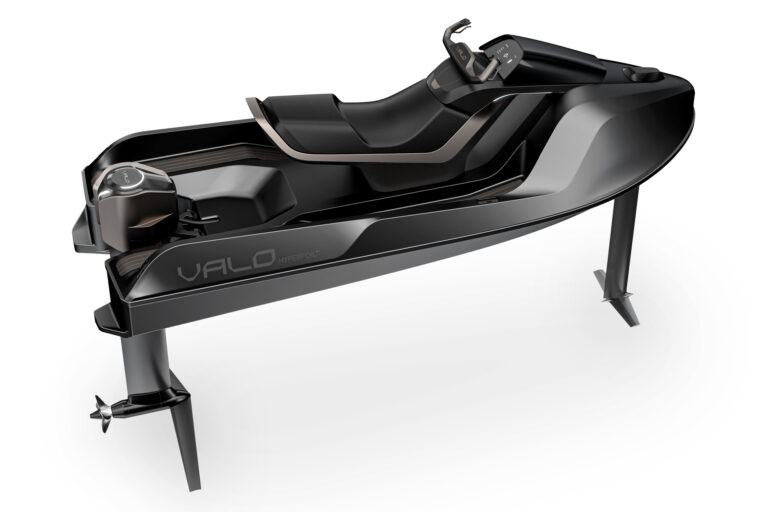
SKY’S THE LIMIT: By breaking the cost-of-entry barrier with a $1.3-million five-seater, Eclipse stands to transform flying and yachting. Eclipse uses compact Pratt & Whitney engines.
As teenagers, Vern Raburn and his buddy William Henry Gates would drag race on the streets of Albuquerque in the wee hours of the morning. It was a pastime that led Bill Gates to several speeding tickets before he became the world’s richest person. In turn, Raburn became the 18th employee at his pal’s start-up company, Microsoft. By the time he retired, he could buy his own jet and then some. But that wasn’t enough.
Which is why Raburn is the father of the Very Light Jet, or VLJ, that is revolutionizing the aviation world-and making yacht owners and brokers very happy campers. At a time when the least expensive private jet costs around $4 million, Raburn’s Eclipse Aviation is beavering away to debut the Eclipse 500, a five-passenger pocket rocket conceived to sell for about $1 million. To bankroll Eclipse, Raburn has attracted an all-star cast, including his drag-racing buddy, Bill Gates, retired DaimlerChrysler CEO Bob Eaton, and retired Ford CEO Harold “Red Poling, who is now the company chairman.
But who wants a million-dollar jet? Well, in addition to the 2,400 people who have shelled out sizable (and non-refundable) deposits at Eclipse alone, we’re probably looking at a large number of yacht owners-or potential yacht owners. As one VLJ representative said at last year’s Monaco Show, “When people sit down to sign a contract on a superyacht, they usually also buy a jet to get them to it.
With the upper-income end of the demographic growing at an unprecedented rate, no wonder Eclipse and a handful of other competitors are taking deposits as fast as the ink dries on the checks. You may not know Eclipse (yet), but Cessna has also jumped on the VLJ bandwagon, along with Adam Aircraft, Diamond Aircraft, Embraer and even Detroit’s nemesis, Honda.
The attraction of the VLJ is multiple. Imagine being able to climb aboard your own jet and fly at close to the speed of commercial airliners. A VLJ like the Eclipse 500 makes it easy-and affordable, because it’s legal for single-pilot operation (unlike more complex bizjets that require copilots). If you like to fly, so much the better: The same rules mean an owner-pilot can fly it himself, which is very appealing to private pilots. Another big draw is that VLJ will have access to more than 10,000 airports nationwide and even more around the world, including literally thousands that have no commercial flights. If you’ve ever wished you could catch up to a cruising yacht’s itinerary at other than large airports, the VLJ’s your ticket. Now when you get a call that the black marlin are biting off Cabo San Lucas, no sweat, you can be there in a couple of hours.
For James Clayton of Cranchi USA, who is seriously considering an Eclipse 500, the attraction is purely business. “We can use it to bring clients to see our yachts and to carry service people to faraway yachts on short notice, he says. “And, when we’re not using it, we can charter it.
The operating cost of a VLJ is a fraction of that for conventional business jets, making it viable not just for business use, but as an air taxi as well. The Federal Aviation Administration, in fact, sees a huge market for by-the-seat air-taxi services that would revolutionize air travel, particularly to smaller airports. The DayJet Corp. of Florida has ordered 309 Eclipse 500s for air-taxi service and expects to offer by-the-seat flights for $1 to $3 a mile.
Eclipse has been going down a rocky road as a start-up company. One of its early problems was relying on the Williams jet engine, a compact and relatively inexpensive engine that had been developed for cruise missiles. As it turned out, the engine didn’t work on the Eclipse, which meant starting over with a compact Pratt & Whitney engine.
Nevertheless, the Eclipse 500 is clearly the leader both in sales and in the certification process, with aircraft expected to start being delivered to customers this summer. But observers have also pointed out that the Eclipse has a few drawbacks. USA Today described it as having “the feel of a soccer mom’s minivan. A larger issue is the absence of even a portable potty. “Go to the bathroom before you fly, is one piece of good advice.
Meanwhile, with decades of experience, Cessna isn’t far behind with its Citation Mustang, a five-seater (with toilet) that is expected to sell for around $2.5 million. A more sophisticated aircraft, the Mustang will probably be delivered to customers late in 2006.
Embraer, the Brazilian aircraft builder that has populated the world’s airlines with short-haul regional jets, is a late starter in the VLJ field but is planning the Phenom 100, a slightly larger aircraft that will deliver in mid-2008 for a guesstimated $2.75 million. With up to seven passengers (plus pilot), it will be wider than the Cessna Mustang with more elbowroom and have a taller 4-foot 11-inch cabin.
While Eclipse invented the VLJ, and Cessna and Embraer brought their considerable experience to bear on the genre, Adam Aircraft is another small company with big ambitions-and can-do attitude. The Adam A700 got a jump start by using parts (wings, tail, etc.) from its already existing twin-boom propeller-driven A500 aircraft, to which they’ve grafted a pair of those Williams jets. The result is a five-passenger VLJ with club configuration (facing seats) plus a lavatory. The A700 is expected to deliver later this year for around $2.1 million.
Diamond Aircraft, a manufacturer that builds its subassemblies in Germany and then finishes the aircraft in Canada, is a dark horse with a less than $1-million single-engined VLJ. The four-seat aircraft is still in development, and no delivery dates have been set. An even darker horse is the HondaJet. Honda originally made it clear that it only wanted to introduce a lightweight jet engine built in conjunction with General Electric, but then built its own aircraft as well.
And the HondaJet is most unusual. Instead of attaching the engines at the back of the fuselage or on pylons (as on larger airliners) under the wing, the HondaJet has the engines on pylons atop the wings. This arrangement allows a bigger cabin (no structure is needed to support the engines in the tail) so there is a comfy six- to eight-seat cabin with an aft lav. While Honda maintains that it has “no business plan for the plane, which is currently in flight testing, the prospect of selling several hundred multimillion dollar aircraft has to appeal to a company that ravaged America’s automakers. Stay tuned.
There are, however, downsides to this sudden infusion of VLJs flitting around at airliner altitudes (40,000-plus feet) and speeds (370 to 400-plus knots) and the most obvious is air-traffic control. Although the FAA predicts that only 100 or so VLJs will be flying by the end of 2006, its estimates suggest that number will grow by 500 to nearly 1,000 a year. Since air-traffic controllers are stretched thin as it is, the prospect of adding a few thousand VLJs hip-hopping between smaller airports isn’t pleasant.
Several other companies have joined the VLJ fray but, with fierce competition for this new market, it’s likely that there will be corporate casualties before the dust settles. Nevertheless, 2006 will be a very important year for VLJs. And as they turn yacht prospects into buyers with the lure of easier and more exotic access, both industries may take wing.
| Very Light Jets at a Glance | |||||
| AirCraft | Price | Passengers | Speed (knots) | Range (nm) | Due Date |
| Eclipse | $1.3 mil | 5 | 375 | 1,280 | July ’06 |
| Cessna Citation Mustang | $2.5 mil | 5 | 420 | 1,150 | Dec. ’06 |
| Embraer Phenom | $2.75 mil | 7 | 380 | 1,160 | mid-2008 |
| Adam A700 | $2.1 mil | 6 | 340 | 1,100 | Dec. ’06 |
| HondaJet | N/A | 7 | 405 | 1,100 | N/A |








